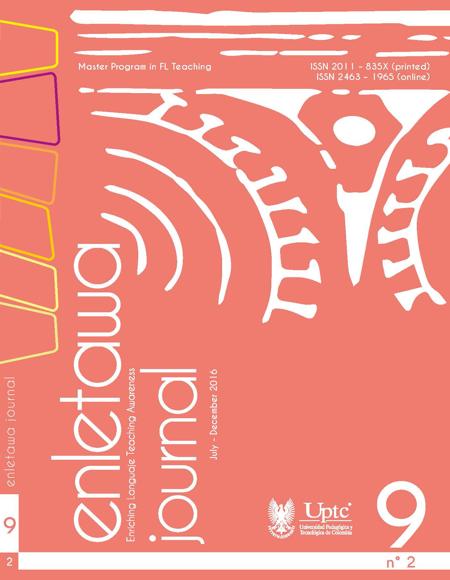A Group of Eleventh Graders’ Life Stories: Reconstructing Social Identity

Resumen
This qualitative and interpretive study aimed to analyze how a group of eleventh graders reconstructed their social identity through life stories and writing related tasks in their native language. This notion is supported in professional literature: “Constructing and reconstructing identity through narratives is like giving sense to the life;” “It is like reorganizing the story lived,” (Park & Burgess, 1924, p. 4). “It is like trying to assume what has happened with the lives and turn them into stories,” (Hardy, 1968, p. 9). The Reconstruction of identity can be expressed through language learning in the way students use narratives; such narratives can provide a glimpse into students’ private world, (Pavlenko, 2007). The instruments from which data was collected were life stories and interviews. The four participants reconstructed their identity with descriptions of overcoming abuse and mistreatment, fighting to survive and to continue ahead, and creating a better life.
Palabras clave
Life stories, Identity, Reconstruction, Social identity, Narratives
Citas
- Altheide, D. (2002). Identity and the definition of the situation in a mass-mediated context. Arizona State University. Handbook of interview research p. 411–430).Thousand Oaks, CA: Sage.
- Barkhuizen, G. (2011). Researcher Identity, Narrative Inquiry, and Language Teaching. Research BONNY NORTON AND MARGARET EARLY University of British Columbia Vancouver, British Columbia, Canada.
- Belk, R. (1988). How do consumers express their identity? School of management working paper series, 2003.17.
- Bruner, J. (1987). Life as narrative. Social Research, 54 (1), 11–32.
- Connelly, F., & Clandinin, D. J. (1990). Stories of experience and Narrative inquiry. Educational Researcher. American Educational Research Association 19, (5) 2-14 Published by: American Educational Research Association. StablURL:http://www.jstor.org/stable/1176100. Accessed: 06/09/2011 11:23 DOI: https://doi.org/10.3102/0013189X019005002
- Creswell, J. (2012). Educational Research. Planning, conducting and evaluating quantitative and qualitative research. FOURTH EDITION. University of Nebraska– Lincoln. Boston Columbus Indianapolis New York San Francisco Upper. p. 206.
- Cumming, A. (2006). Goals for Academic Writing: ESL Students and Their Instructors. Amsterdam: John Benjamins. DOI: https://doi.org/10.1075/lllt.15
- Deng, F. M. (1995). War of Visions: Conflict of Identities in the Sudan. Washington, DC: Brookings.
- Denzin, N.K. (1970, 1989). Interpretive Biography. Newbury Park, CA: Sage. Dowling, S. J. (2011). Constructing Identity. Identity construction.Georgia State University. DOI: https://doi.org/10.4135/9781412984584
- Dowling, S. J. (2011). Constructing Identity. Identity construction. Georgia State University.
- Giddens, A. (1991). Modernity and Self-Identity: Self and Society in the Late Modern Age, Stanford, CA: Stanford University Press, 1991, pp. 187-201.
- Hardy, B. (1968). Towards a Conceptual History of Narrative. Matti Hyvärinen, University of Tampere.
- Hogg & Abrams. (1988). Identity theory and social identity theory. Washington State University.
- Johnson & Christensen. (2010). Educational Research: Quantitative, qualitative and mixed approaches. University of Nebraska – Lincoln Digital Commons: University of Nebraska – Lincoln.
- Levinson, D. (1978). Theories of Identity and the Analysis of Face. University of Warwick institutional repository.
- McAdams & Brown, (2001). The Psychology of Life Stories. Northwestern University. DOI: https://doi.org/10.1037/1089-2680.5.2.100
- McAdams, D. (1993). The stories we live by: Personal myths and the making of the self. New York, NY: Guilford Press.
- MacAdams, D. (1996). Personal narratives and the life story. New York. Oxford University Press.
- Neimeyer, R. A. (2000). Narrative disruptions in the construction of the self’ in R. A. DOI: https://doi.org/10.1037/10368-009
- Norton, B. (2000).Identity and language learning: Gender, ethnicity and educational change. London: Longman/Pearson Education.
- Norton, B. (2007, 20010, 2o11). Identity, Language Learning, and Social Change. University of British Columbia, Canada.
- Park, R. E., & Burgess, E (1924). Assimilation. In introduction to the science of Sociology.Chicago: University of Chicago Press. p. 734-783.
- Patton, M. (1990). Qualitative evaluation and research methods (pp. 169-186). BeverlyHills, CA: Sage. p.169.
- Pavlenko, A. (2007). Autobiographic narratives as data in applied linguistics. Applied Linguistics, 28 (2), 163–188. DOI: https://doi.org/10.1093/applin/amm008
- Pavlenko, A. & A. Blackledge, (2004). Negotiation of identities in multilingual contexts. Multilingual Matters. Clevedon, UK DOI: https://doi.org/10.21832/9781853596483
- Polkinghorne, D. (2007). Analyzing Narratives and Story-Telling Matti Hyvärinen.
- Ricoeur, P. (1991a). Life in quest of narrative. In D. Woods (ed.), On Paul Ricoeur: Narrative and interpretation. London: Routledge, 20–33.
- Riessman, C. (1993). Narrative Analysis. Newbury Park, CA: Sage (2008). Narrative Methods for Human Sciences Newbury Park, CA: Sage.
- Robinson, H. (2007). Handbook of Self and Identity Edited by Mark R. Leary & June Price Tangney, Guilford Press, New York & London.
- Snow, D. A., & Anderson L. (1987). Identity work among the homeless. The verbal construction and avowal of personal identities. DOI: https://doi.org/10.1086/228668
- Squire, C. (2008). Experience-centred and culturally-oriented approaches to narrative. In M. Andrews, C. Squire & M. Tamboukou (eds.), Doing narrative research. Los Angeles: SAGE. Publications, 41–63. DOI: https://doi.org/10.4135/9780857024992.d4
- Squire, C. (2008). Memory and the Sense of Personal Identity, University of California, Santa Barbara.
- Street, B. (2003). What’s “new” in New Literacy Studies? Critical Approaches to Literacy in theory and practice. Current issues in comparative education, 5(2), 77- 91.
- Tajfel, H. (1978). Social identity theory and the organization. Blake E. Ashforth, Concordia University & Fred Mael, Wayne State University.
- Taylor, C. (1989). Sources of the self. The making of the modern identity. Cambridge, MA: Harvard University Press.
- Thorborrow, J. (2005). Language and identity: The sociolinguistics of narrative. Studies in narrative. John Benjamins Publishing Company. Amsterdam/Philadelphia.
- Tudor, I. (2001). The Dynamics of the Language Classroom. Cambridge Language. Teaching Library. Cambridge University Press.
- Wenger, E. (1998-2000). Communities of practice: Learning, meaning, and identity. Cambridge, MA: Cambridge University Press. DOI: https://doi.org/10.1017/CBO9780511803932